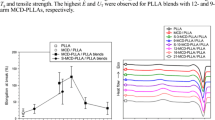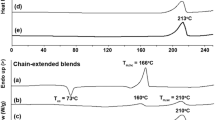Abstract
Multi-arm poly(l-lactide)s (PLLAs) were prepared by using alcohols with different numbers of hydroxyl groups as initiator and Sn(Oct)2 as catalyst. The structure and composition was confirmed by NMR and GPC analysis. A series of blends of PLLA/multi-arm PLLA were prepared by melt-mixing. Several techniques were applied to investigate the effects of multi-arm PLLA on the melt rheology, crystallization, thermal stability, morphology and mechanical properties of the linear PLLA. Multi-arm PLLA enhanced crystallization rate of PLLA as a nucleating agent. Rheological analysis showed that the viscosity of PLLA at low frequencies increased after addition of multi-arm PLLA. In addition, the tensile strength was increased with the increase of multi-arm PLLA and can achieve a maximum. FE-SEM measurements revealed that the surface of blends was homogenous, indicating good compatibility between PLLA and multi-arm PLLA. The results had an important guiding role in PLA modification, which provided an opportunity for generating new PLA blending systems with enhanced properties.












Similar content being viewed by others
References
Nampoothiri KM, Nair NR, John RP (2010) An overview of the recent developments in polylactide (PLA) research. Bioresour Technol 101:8493–8501
Auras R, Harte B, Selke S (2004) An overview of polylactides as packaging materials. Macromol Biosci 4:835–864
Rasala RM, Janorkarc AV, Hirta DE (2010) Poly(lactic acid) modifications. Prog Polym Sci 35:338–356
Lima LT, Aurasb R, Rubinob M (2008) Processing technologies for poly(lactic acid). Prog Polym Sci 33:820–852
Wang RY, Wang SF, Zhang Y, Wan CY, Ma PM (2009) Toughening modification of PLLA/PBS blends via in situ compatibilization. Polym Eng Sci 49:26–33
Al-Itry R, Lamnawar K, Maazouz A (2012) Improvement of thermal stability, rheological and mechanical properties of PLA, PBAT and their blends by reactive extrusion with functionalized epoxy. Polym Degrad Stabil 97:1898–1914
Xu HJ, Fang HG, Bai J, Zhang YQ, Wang ZG (2014) Preparation and characterization of high-melt-strength polylactide with long-chain branched structure through γ-radiation-induced chemical reactions. Ind Eng Chem Res 53:1150–1159
You JX, Lou LJ, Yu W, Zhou CX (2013) The preparation and crystallization of long chain branching polylactide made by melt radicals reaction. J Appl Polym Sci 129:1959–1970
Dean KM, Petinakis E, Meure S, Yu L, Chryss A (2012) Melt strength and rheological properties of biodegradable poly(lactic acid) modified via alkyl radical-based reactive extrusion processes. J Polym Environ 20:741–747
Jikei M, Suzuki M, Itoh K, Matsumoto K, Saito Y, Kawaguchi S (2012) Synthesis of hyperbranched poly(l-lactide)s by selfpolycondensation of AB2 macromonomers and their structural characterization by light scattering measurements. Macromolecules 45:8237–8244
Wei XF, Bao RY, Cao ZQ, Yang W, Xie BH, Yang MB (2014) Stereocomplex crystallite network in asymmetric PLLA/PDLA blends: formation, structure, and confining effect on the crystallization rate of homocrystallites. Macromolecules 47(4):1439–1448
Shin BY, Han DH, Narayan R (2010) Rheological and thermal properties of the PLA modified by electron beam irradiation in the presence of functional monomer. J Polym Environ 18:558–566
Rathi SR, Coughlin EB, Hsu SL, Golub CS, Ling GH, Tzivanis MJ (2014) Maintaining structural stability of poly(lactic acid): effects of multifunctional epoxy based reactive oligomers. Polymers 6(4):1232–1250
Choi KM, Choi MC, Han DH, Park TS, Ha CS (2013) Plasticization of poly(lactic acid) through chemical grafting of poly(ethylene glycol) via in situ reactive blending. Eur Polym J 49:2356–2364
He YS, Zeng JB, Liu GC, Lia QT, Wang YZ (2014) Super-tough poly(l-lactide)/crosslinked polyurethane blends with tunable impact toughness. RSC Adv 4:12857–12866
Ojijo V, Ray SS, Sadiku R (2014) Concurrent enhancement of multiple properties in reactively processed nanocomposites of polylactide/poly[(butylene succinate)-co-adipate] blend and organoclay. Macromol Mater Eng 299(5):596–608
Wang LY, Jing XB, Cheng HB, Hu XL, Yang LX, Huang YB (2012) Rheology and crystallization of long-chain branched poly(l-lactide)s with controlled branch length. Ind Eng Chem Res 51(33):10731–10741
Hao YP, Liang HY, Bian JJ, Sun SL, Zhang HL, Dong LS (2014) Toughening of polylactide with epoxy-functionalized methyl methacrylate-butadiene copolymer. Polym Int 63(4):660–666
Ma P, Cai X, Zhang Y, Wang S, Dong W, Chen M, Lemstra PJ (2014) In-situ compatibilization of poly(lactic acid) and poly(butylene adipate-co-terephthalate) blends by using dicumyl peroxide as a free-radical initiator. Polym Degrad Stabil 102:145–151
Huang Y, Zhang CM, Pan YH, Wang WW, Jiang L, Dan Y (2013) Study on the effect of dicumyl peroxide on structure and properties of poly(lactic acid)/natural rubber blend. J Polym Environ 21(2):375–387
Trollsås M, Kelly MA, Claesson H, Siemens R, Hedrick JL (1999) Highly branched block copolymers: design, synthesis, and morphology. Macromolecules 32:4917–4924
Miao Y, Rousseau C, Mortreux A, Martin P, Zinck P (2011) Access to new carbohydrate-functionalized polylactides via organocatalyzed ring-opening polymerization. Polymer 52(22):5018–5026
Dria RD, Goudy BA, Moga KA, Corbin PS (2012) Synthesis and characterization of multi-armed calixarene- and resorcinarenecore polylactide star polymers. Polym Chem 3:2070–2081
Phuphuak Y, Chirachanchai S (2013) Simple preparation of multi-branched poly(l-lactic acid) and its role as nucleating agent for poly(lactic acid). Polymer 54:572–582
Acknowledgments
This work was supported by Grants from National Natural Science Foundation of China (Key Project 51203155, Project 51303176), National High-tech R&D Program of China (863 Program Project 2015AA034004).
Author information
Authors and Affiliations
Corresponding authors
Rights and permissions
About this article
Cite this article
Bian, X., Zhang, B., Sun, Z. et al. Synthesis of multi-arm poly(l-lactide) and its modification on linear polylactide. Polym. Bull. 74, 245–262 (2017). https://doi.org/10.1007/s00289-016-1713-4
Received:
Revised:
Accepted:
Published:
Issue Date:
DOI: https://doi.org/10.1007/s00289-016-1713-4




